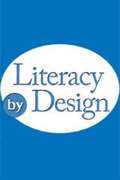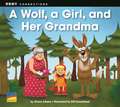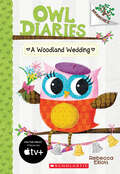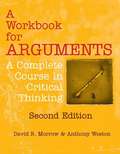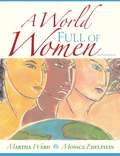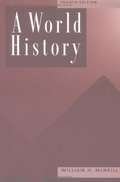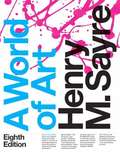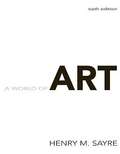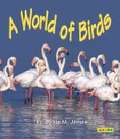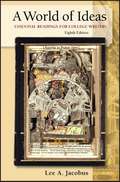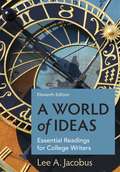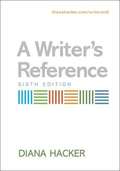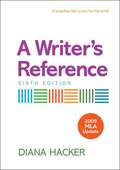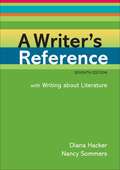- Table View
- List View
A Wisdom Of Words
by Rohini OommanA Wisdom of Words is a series of English readers from Std I to Std. VIII. The word, 'Wisdom' is used as a collective noun for the collection of stories and poems that cover a wide range of fiction, non-fiction and poems and is intended to enrich young readers' experiences of the world around them.
A Wolf, a Girl, and Her Grandma
by Bill Greenhead Alison Adams Jeffrey B. FuerstNIMAC-sourced textbook
A Woodland Wedding: A Branches Book (Owl Diaries #3)
by Rebecca ElliottIn the third installment of this New York Times bestselling series Eva's teacher is getting married -- and the whole class is invited to the wedding!Pick a book. Grow a Reader!This series is part of Scholastic's early chapter book line called Branches, which is aimed at newly independent readers. With easy-to-read text, high-interest content, fast-paced plots, and illustrations on every page, these books will boost reading confidence and stamina. Branches books help readers grow!Eva's teacher, Miss Featherbottom, is getting married. All of her students have been invited to the wedding. And Eva starts a Secret Wedding Planners Club! But before Miss Featherbottom walks down the aisle, her necklace goes missing. Eva wants to help! She quickly turns her Wedding Planners Club into a Detectives Club. Can Eva track down the missing necklace before Miss Featherbottom's wedding is ruined?Continue this book series with “Eva the Owlet,” an Apple TV+ original series!
A Workbook for Arguments: A Complete Course in Critical Thinking, Second Edition
by Anthony Weston David R. MorrowA Workbook for Arguments builds on Anthony Weston’s A Rulebook for Arguments to provide a complete textbook for a course in critical thinking or informal logic. The second edition adds: Updated and improved homework exercises—nearly one third are new—to ensure that the examples continue to resonate with students. Increased coverage of scientific reasoning, demonstrating how scientific reasoning dovetails with critical thinking more generally Two new activities in which students analyze arguments in their original form, as provided in brief selections from the original texts. This edition continues to include: The entire text of Rulebook, supplemented with extensive explanations and exercises. Homework exercises adapted from a wide range of arguments in a wide variety of sources. Practical advice to help students succeed. Model answers to odd-numbered problems, including commentaries on the strengths and weaknesses of selected sample answers and further discussion of some of the substantive intellectual, philosophical, or ethical issues they raise. Detailed instructions for in-class activities and take-home assignments. An appendix on mapping arguments, giving students a solid introduction to this vital skill in constructing complex and multi-step arguments and evaluating them.
A World Full of Women (5th edition)
by Martha Ward Monica EdelsteinWelcome to a world full of women. This book has two goals: to explore and validate woman-centered experiences, and to illuminate the common grounds of being female on Planet Earth.
A World History
by William H. McNeillGlobal in scope, William McNeill's widely acclaimed one-volume history emphasizes the four Old World civilizations of the Middle East, India, China, and Europe, paying particular attention to their interaction across time as well as the impact on historical scholarship in light of the most recent archaeological discoveries. The engaging and informative narrative touches on all aspects of civilization, including geography, communication, and technological and artistic developments, and provides extensive coverage of the modern era. This new edition includes a thoroughly updated bibliographic essay and a new discussion of the most significant events in world history and civilization since 1976.
A World of Art
by Henry SayreA World of Art fosters the critical thinking and visual literacy skills students need to understand art from around the globe. Noted author and educator Henry Sayre teaches students how to ask the right questions about the visual world that surrounds us, and to then respond meaningfully to the complexity of that world. New to the eighth edition, seven thematic chapters help students better identify and understand major themes of art—such as “the cycle of life” and “the body, gender, and identity”—that transcend different eras and regions.
A World of Art (Seventh Edition)
by Henry M. SayreA World of Art is a fascinating book that welcomes all students to have an inner eye, think better and appreciate art.Henry M. Sayre explains that by appreciating art; you don't have to like it; but it advances your observation to a completely out of the world view.has proved helpful in several professions; medicine in the diagnostic and surgical processes, police department in observation and these are just examples. The world is filled with images and only if you are keen and actively observant would you be able to understand them. The formatting in this book will help you, the reader, take you through every step of the visual world.
A World of Art (Sixth Edition)
by Henry M. SayreWhy A World of Art? Henry Sayre wrote the first edition of World of Art because he wanted to use a text in his own art appreciation course that truly represented all artists, not just the Western canon found at that time in the other texts. He also wanted a text that fostered critical thinking through looking at, talking about, and questioning works of art for his students. We are proud to present the new sixth edition of World of Art, which further strengthens these two key aspects of the text while presenting hot topics like video and time-based media.
A World of Books: Assessment Pack (Great Minds Wit & Wisdom #Grade 1, Module 1)
by Ann Brigham Lauren Chapalee Lorraine GriffithNIMAC-sourced textbook
A World of Ideas: Essential Readings for College Writers
by Lee A. JacobusThe most successful reader of its kind,A World of Ideas introduces first-year writing students to the thinkers and writers whose ideas have shaped civilization: for example, Niccolò Machiavelli on government, Elizabeth Cady Stanton on justice, and Sigmund Freud on the mind. Because students perceive these writers as important, they take the writing course seriously: they learn to read more attentively, think more critically, and write more effectively. No other composition reader offers a comparable collection of important readings along with the supportive apparatus students need to understand, analyze, and respond to them.
A World of Ideas: Essential Readings for College Writers
by Lee A. JacobusThe book engages students with the big ideas that have shaped society and are reshaping it today. Readings by essential authors -help students trace the origins of central cultural concepts and respond to them. A World of Ideas asks such crucial questions as, What defines good government? What forces shape our society? What does it mean to be educated? The text helps students respond to these questions by providing the guidance they need to understand, analyze, and write. Substantial, supportive apparatus helps students focus on both the content of the readings as well as the rhetorical moves that writers use to achieve their purposes, providing instruction and models as students join in the important conversations continuing today. New chapters on Education and Gender, and new readings throughout, speak to today's urgent concerns. Improved writing instruction includes more scaffolding and examples that provide greater support for students.
A Writer's Reference
by Diana Hacker Nancy Sommers Tom Jehn Jane RosenzweigHaving helped nearly 3 million students at 1,600 colleges and universities to write well,A Writer's Referencesucceeds because it has always been grounded in classroom experience. Nearly twenty years ago, Diana Hacker reinvented the college handbook by looking at her own students' needs. She crafted a first-of-its-kind reference that offered practical solutions to college writing problems in a language students could understand and in a format that was easy for them to use. Her many innovations -- hand-edited sentences, grammar checker boxes, student-friendly index entries, ESL coverage, and a lay-flat comb binding -- have been widely imitated but never improved upon. In the Hacker tradition, the new contributing authors -- Nancy Sommers, Tom Jehn, Jane Rosenzweig, and Marcy Carbajal Van Horn -- have crafted solutions for the writing problems of today's college students. Together they give us a new edition that provides more help with academic writing and that works better for a wider range of multilingual students.
A Writer's Reference (6th Edition with 2009 MLA Update)
by Diana HackerRead this to find out more about the 2009 MLA updates and the 2010 APA updates. A Writer's Reference is the most widely adopted college handbook ever published. The new edition is available in a classic version that provides more help with academic writing, serves a wider range of multilingual students, and lends more support for college research -- all in an easy-to-use quick-reference format. Now for all the ways you teach your course, you can choose the classic version or choose from among 4 additional versions with varied content. A Writer's Reference with Exercises is tailor-made for classroom use or for additional grammar practice with 86 integrated exercise sets. A Writer's Reference with Writing in the Disciplines provides help for college writing beyond composition with advice and models in six academic disciplines. A Writer's Reference with Writing about Literature includes an entire tabbed section on interpreting and writing about works of literature, with two annotated student essays. A Writer's Reference with Extra Help for ESL Writers includes an entire tabbed section for nonnative speakers of English; it offers targeted advice and strategies for college writing and research.
A Writer's Reference: With Writing About Literature
by Diana Hacker Nancy SommersThis version of the best selling college handbook includes a tabbed section called Writing about Literature, a practical guide to interpreting works of literature and to planning, composing, and documenting papers about literature. Students will find help with forming and supporting an interpretation, avoiding plot summary, integrating quotations from a literary work, observing the conventions of literature papers, and using secondary sources. Writing about Literature also includes two sample student essays — one that uses primary sources and one that uses primary and secondary sources. The full primary texts are also included.
A Writer’s Reference (6th edition)
by Diana HackerA Writer's Reference is the most widely adopted college handbook ever published. The new edition is available in a classic version that provides more help with academic writing, serves a wider range of multilingual students, and lends more support for college research -- all in an easy-to-use quick-reference format. Now for all the ways you teach your course, you can choose the classic version or choose from among 4 additional versions with varied content. A Writer's Reference with Exercises is tailor-made for classroom use or for additional grammar practice with 86 integrated exercise sets. A Writer's Reference with Writing in the Disciplines provides help for college writing beyond composition with advice and models in six academic disciplines. A Writer's Reference with Writing about Literature includes an entire tabbed section on interpreting and writing about works of literature, with two annotated student essays. A Writer's Reference with Extra Help for ESL Writers includes an entire tabbed section for nonnative speakers of English; it offers targeted advice and strategies for college writing and research.
